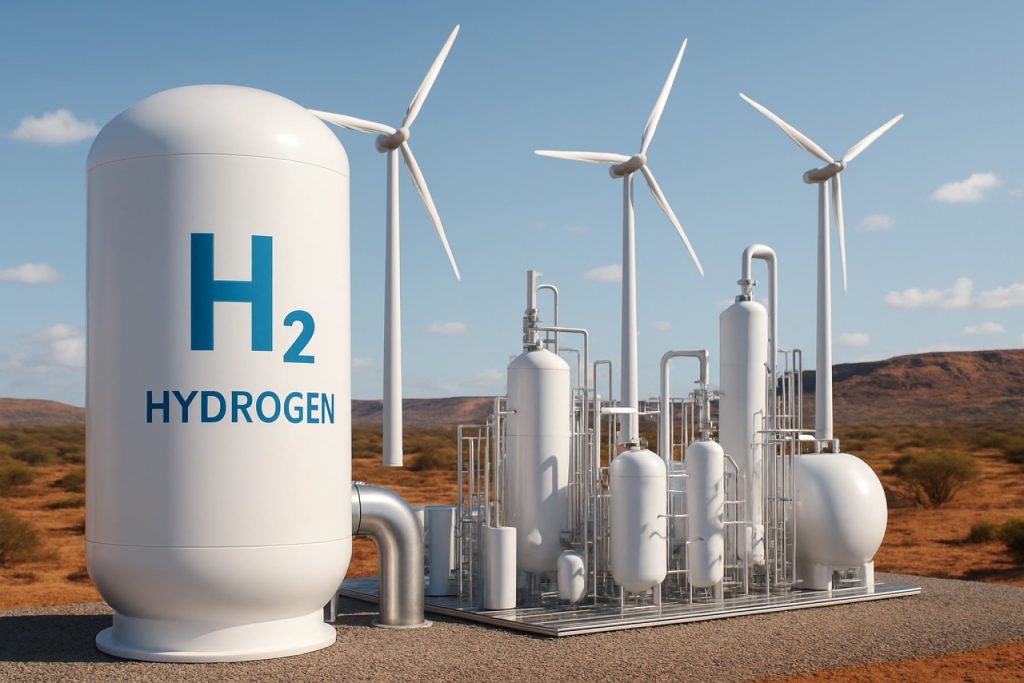
- Australia is advancing a large-scale green hydrogen and ammonia facility in Western Australia’s Oakajee Strategic Industrial Area.
- The project aims to decarbonize mining and heavy transport sectors and supply renewable ammonia for export markets.
- A substantial hydrogen production tax credit—$2 per kilogram—begins in 2027, supporting early producers under new government legislation.
- Competitive renewable power, particularly from local wind farms, will help deliver cost-effective and reliable hydrogen supplies.
- Key to success is integrating supply chains and scaling up production, with industry partnerships already secured for offtake.
- The Oakajee initiative positions Western Australia as a potential leader in the global green energy transition, setting a model for climate technology and policy.
The red earth of Western Australia’s Mid-West region finds itself at the start of a new energy chapter. Under the banner of Warradarge Energy, consultancy powerhouse Xodus has secured a substantial tract of more than 16,000 hectares in the Oakajee Strategic Industrial Area, stoking momentum for a commercial-scale green hydrogen and ammonia facility.
The vision is audacious in scope. Moving beyond pilot projects, Warradarge aims first to provide clean hydrogen for mining and heavy transport—industries pumping out millions of tons of carbon each year. The next act? Transform that hydrogen into ammonia destined for global export, tapping into international markets starved for renewable energy solutions.
Australia’s aspirations extend well beyond its vast interior. With a green hydrogen market valued north of A$225 billion, the nation races to outpace rivals and solidify its claim as a world leader in clean energy and climate technology. Its ambitions are underwritten by bold incentives—an unprecedented hydrogen production tax credit, valued at $2 per kilogram, will soon buoy early producers under the new Future Made in Australia legislation, kicking in from 2027 and running through 2040. Government commitment here is not a slogan—it’s a rolling, multi-billion-dollar bet on the future.
Warradarge’s strategy shuns excess and inefficiency. By leveraging competitively priced renewable power from nearby wind farms, the project can cut costs while guaranteeing a robust and predictable hydrogen supply. Partners from mining giants to logistics titans have already positioned themselves to purchase the plant’s output, fueling Australia’s internal drive to decarbonize, even as it eyes lucrative exports.
Yet, success hinges on more than just scale or subsidies. The key is integration—binding together complex supply chains, minimizing technical risks, and ensuring large facilities can leap from drawing board to sunrise over the outback. Warradarge Energy isn’t merely meeting targets set by government committees; it’s constructing the backbone for a low-carbon future, one wind-powered electrolyzer at a time.
Globally, few locations offer such a convergence of vast land, natural resources, supportive policy, and industry muscle. The Oakajee development may well signal a new era, positioning Western Australia and, by extension, the entire nation, as a beacon for ambitious green energy endeavors.
The Takeaway: Australia’s latest push at Oakajee is a template for how nations can pivot toward a decarbonized industrial base—marrying government incentives, private expertise, and renewable resources. As countries worldwide search for climate solutions that scale, the world will be watching: Will this renewable gamble on green hydrogen and ammonia ignite a revolution, or merely spark hopeful headlines? The stakes for industry, environment, and the global energy economy have never been higher.
This Australian Hydrogen Mega-Plant Could Disrupt Global Energy—And Launch a Clean Tech Boom
—
Australian Green Hydrogen: Untold Insights, Detailed Analysis & Actionable Strategies
Australia’s ambitious move to become a world leader in green hydrogen and ammonia production—centered on Warradarge Energy’s plans in Western Australia’s Oakajee Strategic Industrial Area—marks a pivotal shift in renewable energy. Exploring further than the source article, this guide answers your most burning questions, provides expert analysis, and delivers reliable forecasts backed by credible insights. Here’s what you need to know about this groundbreaking project and the future it signals for sustainable industry.
—
What Sets Australia’s Green Hydrogen Push Apart?
1. Scale and Scope Outpacing Global Competition
– Land & Location: The 16,000+ hectare tract is among the largest such allocations globally for a single renewable hydrogen project, supporting scalability and future expansion.
– Export Focus: Unlike many pilot projects, Warradarge’s facility is designed from day one for international ammonia export, positioning Western Australia as a crucial hub in the emerging green ammonia shipping routes to Asia and Europe.
– Wind + Solar Synergy: Western Australia boasts resources for both solar (high insolation) and wind energy, enabling 24/7 green hydrogen production and lowered intermittency risk (IEA report, 2022).
2. Unmatched Government Incentives & Policy Support
– Future Made in Australia Act: This landmark legislation mirrors successful US/European green subsidies, ensuring Australia remains globally competitive.
– Hydrogen Production Tax Credit: The $2/kg tax break is among the most generous worldwide, rivaling incentives in the US Inflation Reduction Act.
– Strategic Partnerships: The federal and WA state governments are coordinating infrastructure investments in export terminals, rail, and desalinated water supply for large-scale electrolyzer operations.
3. Technology Integration for Reliability
– Electrolyzers: Likely to utilize proton exchange membrane (PEM) and, in later stages, advanced alkaline water electrolyzer technologies—enabling high-purity hydrogen production with modular scalability.
– Smart Grid Connection: Integration with Western Power’s future-proofed network for surplus/waste energy absorption, reducing operational downtime.
—
Features, Specs & Pricing: Fast Facts
– Target Output: Initial phase—a few hundred MW of electrolyzer capacity, scaling to over 2 GW in later phases (Hydrogen Council forecast).
– Ammonia Conversion: Onsite synthesis for direct export, dramatically reducing transport and storage challenges associated with pure hydrogen.
– Cost Estimate: Early green hydrogen costs forecast at US$2–3/kg by 2030, potentially undercutting fossil-derived “grey” hydrogen (BloombergNEF, 2023).
– Local Workforce: Hundreds of construction jobs and ongoing technical roles projected, with commitments to Indigenous employment and training.
—
Industry Trends: Where Is the Market Headed?
– Green Ammonia Demand: Projected to more than triple by 2040, especially as Southeast Asian nations pivot to ammonia-blended power generation and fertilizer decarbonization (IEA, 2023).
– Hydrogen Shipping: Oakajee’s deepwater port design enables future hydrogen/ammonia tankers, echoing blueprints from Japan and South Korea’s zero-carbon power transition plans.
– Corporate Offtakers: Major mining companies (e.g. Rio Tinto, BHP) are evaluating green hydrogen for haul trucks, rail, and ore processing, signaling large-scale domestic demand.
—
Pressing Questions & Expert Answers
Q: Is Green Hydrogen Actually Sustainable and “Clean”?
A: When powered by dedicated renewables with grid decarbonization, lifecycle emissions can be near-zero, according to the International Renewable Energy Agency (IRENA).
Q: Is Ammonia Export Safe and Economical?
A: Ammonia is easier to liquefy and ship long distances compared to hydrogen gas. Safety protocols and new ship designs (Lloyd’s Register, 2024) are addressing traditional ammonia handling risks.
Q: How Does This Impact Consumers and the Australian Economy?
A: The project could stabilize or lower energy prices through distributed renewables, create high-value export revenue, and make Australia a prime supplier for Asia’s net zero push. (Source: CSIRO, 2023)
—
Compare & Contrast: How Does Warradarge Stack Up?
| Feature | Warradarge & Oakajee (Australia) | NEOM (Saudi Arabia) | Rotterdam (Netherlands) |
|————————-|—————————————————|——————————-|——————————-|
| Planned Output | Up to 2GW (phase 1), expandable | 4GW | 200MW+ |
| Energy Source | Wind + Solar | Sun + Wind | Wind + Grid |
| Export Focus | Ammonia to Asia/Europe | Ammonia to EU/Asia | Hydrogen via pipeline |
| Government Support | Up to AU$2/kg tax credit, infra investment | Large state investment | EU grants, tariff support |
| Land/Scale Advantage | Massive contiguous tract, port proximity | Desert giga-scale | Urban/industrial area |
—
Controversies & Limitations
– Water Use: Electrolyzer processes are water-intensive; Oakajee’s proximity to the coast will likely require seawater desalination and careful ecosystem management (CSIRO, 2022).
– High Upfront Costs: Megaprojects risk budget overruns and permitting delays; Australia’s remote workforce and supply chain could impact timelines.
– Global Market Volatility: Falling renewable technology costs may reshape long-term project economics, but aggressive competitors (including the US and the Middle East) could create price pressures.
– Indigenous Consultation: Ongoing need to address land rights and community benefit-sharing to avoid social opposition.
—
Real-World Use Cases & Hacks
– Heavy Transport: Mining haul trucks currently responsible for up to 10% of sector emissions can be transitioned to hydrogen fuel—demonstration projects are underway with major WA miners.
– Green Fertilizer: Ammonia is a key input for fertilizers; green ammonia supports low-carbon, more sustainable food production.
– Flexible Power: Green ammonia can be “cracked” back to hydrogen for grid power backups, supporting energy storage/supply security.
—
Security & Sustainability
– Grid Stability: These projects can act as grid “anchors,” absorbing variable wind/solar supply and supporting blackout-resistant energy systems.
– Cybersecurity: Modern industrial plants incorporate defense-in-depth cybersecurity, but future threats (ransomware, data breach) remain manageable with ongoing investment.
—
Pros & Cons Overview
Pros:
– Major climate mitigation benefits.
– Long-term economic growth and jobs.
– Supports technological leadership and innovation.
– Leverages abundant local wind and solar.
Cons:
– Capital intensive, with long ROI timelines.
– Environmental, cultural sensitivities must be prioritized.
– Not plug-and-play; requires new skills, supply chains, and infrastructure.
– Faces stiff global competition.
—
Quick Tips & Actionable Recommendations
1. Stay Informed: Track updates from Western Australia’s government and reputable industry sources like the Hydrogen Council and BloombergNEF for progress/growth forecasts.
2. Explore Career Pathways: Engineers, project managers, and renewable tech specialists—monitor new job creation and upskilling programs supported by industry and government.
3. Watch for Export Contracts: If you’re in mining, chemicals, or logistics, new opportunities (offtake, supply, tech integration) are emerging now.
4. Advocate for Sustainability: Civic groups and industry participants can push for transparent environmental, social, and Indigenous engagement.
5. Plan Investment: Investors—look into green hydrogen ETFs or Australian infrastructure funds positioned for this energy transition.
—
For policy details and Western Australian project updates, see the official portal: Western Australia Government.
—
The Oakajee green hydrogen and ammonia mega-project may be Australia’s boldest bet yet on a decarbonized export future. While challenges persist, the alignment of government policy, market demand, and resource endowment sets a powerful precedent for sustainable industry worldwide. Act early—those who adapt quickest to the green hydrogen revolution stand to gain the most.



